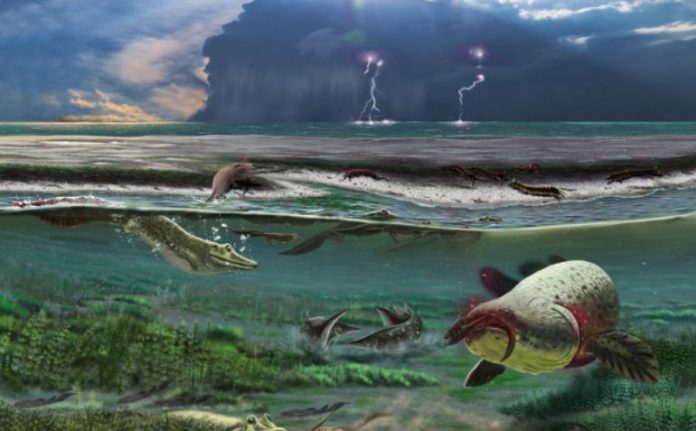One of the oldest tetrapods, who lived 372 million years ago, led a predominantly aquatic lifestyle. Like modern crocodiles, Parmastega aelidaefloated on the surface of the water, watching for prey on the ground. But, most likely, he could not be on land for a long time, since most of his skeleton either consisted of cartilage or was not completely ossified.
The ancestors of the four-legged air-breathing animals, from which the amphibians descended, were presumably lapidate fish. Apparently, the first tetrapods (tetrapods) appeared rather quickly, over several million years at the end of the Devonian period. The first known traces of tetrapods were left about 395 million years ago, and their oldest partial fossils date back to 380 million years ago. Neither traces nor fragments of fossils gave an idea of the appearance of the first tetrapods. But we know what acantostega and ichthyostega looked like – tetrapods, who lived about 365 and 360-365 million years ago, respectively. Compared to the fossils of other Devonian tetrapods, their remains are well preserved.
Now paleontologists have studied the appearance of a more ancient representative of tetrapods. Researchers from Russia, Sweden, the United Kingdom, and Latvia have found and described the well-preserved remains of a four-legged animal that lived about 372 million years ago. The remains of Parmastega aelidae, as the animal was called, were found in the Sosnogorsk formation in the Komi Republic in the north-west of the European part of Russia. The skull and bones of the shoulder girdle of the tetrapod have been preserved. Interestingly, the skeleton of the shoulder girdle was ossified only partially.
Apparently, the animal led a largely aquatic lifestyle. It lived in a lagoon, on the banks of which there was a plain with tropical vegetation. Aelida had a crocodile-like face with sharp teeth, fangs and nostrils at the tip, and closely set eyes, body length was about a meter. The structure of the nostrils indicated that the Devonian tetrapod was breathing with gills, not lungs. Judging by the structure of the eye sockets, the eyes looked up. This suggests that P.aelidae, probably, like modern crocodiles, spent a lot of time swimming on the surface and looking for something on land. Possibly P.aelidae looked for on land other ancient tetrapods, or arthropods, which gradually settled on the land. On the other hand, he hardly ate only arthropods, and besides that, the Aelid had fangs, so he probably hunted vertebrates. Therefore, it is possible that he was looking for fish carcasses that he washed ashore.
From the skeleton of P.aelidae, only the skull and shoulder girdle were preserved, but the researchers also did not find traces of the skeleton being disturbed and the bones scattered after the death of the animal. Therefore, they suggested that the rest of the skeleton was not preserved, since it consisted of cartilage or was not completely ossified. This, in turn, suggests that the Aelid could hardly remain on land for a long time. Moreover, judging by the structure of the bones of the shoulder girdle, he already had limbs, not fins. On the other hand, traces of a tetrapod, 395 million years old, indicate that the bones of his limbs were ossified, since he could walk, even in water. According to researchers, this suggests that parallel evolution occurred in different groups of tetrapods.
As the phylogenetic analysis showed, the Aelids belonged to the sister group in relation to all other ancient tetrapods, but was not the ancestor of any of them.
